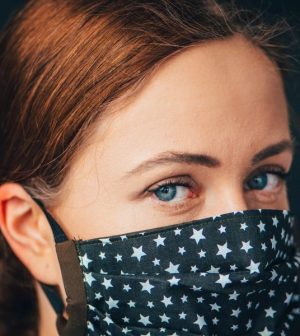- Skip Storing This Everyday Product in the Fridge Door
- Green Tea + B3 Pairing May Boost Brain Health
- Navigating Your Midlife Crisis: Embracing New Possibilities
- City Raccoons Showing Signs of Domestication
- Mapping the Exposome: Science Broadens Focus to Environmental Disease Triggers
- One Week Less on Social Media Linked to Better Mental Health
- Your Brain Changes in Stages as You Age, Study Finds
- Some Suicide Victims Show No Typical Warning Signs, Study Finds
- ByHeart Formula Faces Lawsuits After Babies Sickened With Botulism
- Switch to Vegan Diet Could Cut Your Greenhouse Gas Emissions in Half
Cloth Masks Don’t Cut It for Keeping COVID Away

If you’re counting on a cloth mask to protect you from COVID-19, you may need to re-think that strategy, a new study shows.
Researchers found that cloth face masks do little to fend off tiny airborne particles, while concluding that specialized N95 and similar masks do a much better job.
“Masks are air filters, and woven fabrics, such as cotton, make for good jeans, shirts, and other apparel, but they are lousy air filters,” said study co-author Richard Sear. “So, use woven fabric for clothing, and N95s, FFP2s or KF94s for masks,” added Sear, of the University of Surrey in England.
COVID-19 is transmitted primarily via airborne particles. An infected person breathes out virus-carrying particles that can be inhaled by another person, causing them to become infected.
That’s why masks are widely considered an important first-line defense against airborne transmission of the disease, but, as research is increasingly showing, not all masks provide equal levels of protection.
In this study, published March 1 in the journal Physics of Fluids, researchers compared woven fabric masks with N95 masks and similar face coverings. They looked to see how effective they are at filtering out particles a micrometer and larger in diameter.
Airflow simulations showed that when breathing through cloth, most of the air flows through the gaps between the fibers in cloth masks, bringing with it with more than 90% of the particles.
“In other words, these relatively large gaps are responsible for cloth being a bad material to make air filters from,” Sear said in a journal news release.
“In contrast, the filtering layer of an N95 mask is made from much smaller, 5-micrometer fibers with gaps that are 10 times smaller, making it much better for filtering nasty particles from the air, such as those containing virus,” Sear explained.
Sear noted that good masks should feature the “two Fs: good filtration and good fit.”
“Surgical masks fit badly, so a lot of air goes unfiltered past the edges of the mask by the cheeks and nose,” Sear said.
More information
The U.S. Centers for Disease Control and Prevention offers a guide to masks.
SOURCE: Physics of Fluids, news release, March 1, 2022
Source: HealthDay
Copyright © 2025 HealthDay. All rights reserved.










